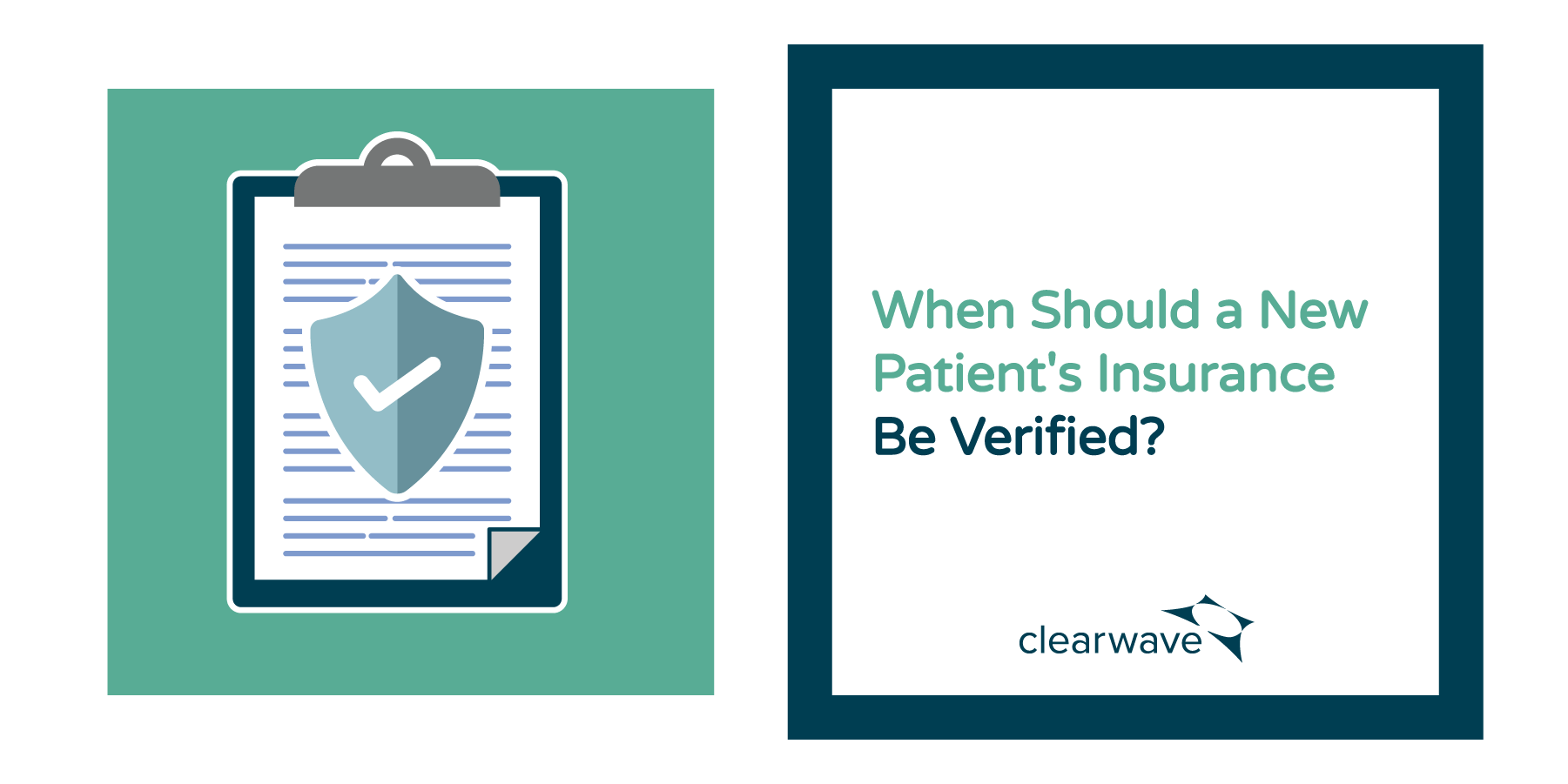When Should a New Patient’s Insurance Be Verified?

By Chloe From Clearwave | December 7, 2023
Specialty practices can significantly reduce bad debt and improve collections by verifying patient insurance coverage early and often. However, manual verification is a major bottleneck and most automated solutions only verify insurance once.
Automating insurance verification is a game changer for medical practices. With a real-time insurance verification solution, you can automatically check patient insurance and determine co-pays and benefits instantly and without staff intervention. The right insurance verification solution must maximize staff productivity, minimize billing errors, prevent revenue leakage and ultimately boost reimbursement rates and cash flow. However, finding the right solution can be tricky, as not all solutions work the same.
Keep reading to learn how real-time verification at multiple patient touch points helps practices reduce claims rejections, speed up reimbursement and improve staff productivity.
When Should a New Patient’s Medical Insurance Be Verified?
High-growth practices automatically verify patient insurance at least seven times per patient engagement, without added costs or staff involvement. This is because verifying insurance only once, such as at time of scheduling, leads to stale patient information. Often, when practices run eligibility just once, they often cannot collect the correct patient payment at the point-of-service. Later in the billing cycle, the practice also faces increased claim rejections due to inaccurate insurance data.
Considering a patient’s propensity to pay drops to just 30% once they leave the office, having a way to run eligibility checks multiple times, quickly and without added fees, is imperative. Running real-time verification throughout the patient journey ensures accurate co-pays are collected upfront and clean claims are submitted. This prevents revenue leakage and accelerates reimbursement for the practice.
Imagine how much more you could collect if you could drastically drop your number of patients with expired eligibility? Here are a few examples of when a multi-factor eligibility™ solution will verify patient insurance, and why it’s important at each of these touch points.
Verify Insurance at First Contact
As soon as the appointment is scheduled, a patient insurance check should be completed immediately. Obtaining eligibility information upfront prevents issues later in the revenue cycle and gives staff a heads up on any errors that they’ll need to solve. Your scheduling workflows should include an automatic insurance verification step to confirm coverage, deductibles, copays or coinsurance required and any need for prior authorization.
Verify Again as the Appointment Nears
Insurance status can change often. If appointments were made months in advance like during check-out after a previous appointment for example, then the likelihood of insurance changing ahead of that next appointment increases. Even in between follow up appointments, patients can change jobs or their employer can change insurance companies as well. Children could age out of their parent’s insurance or gain secondary insurance. Verifying insurance therefore in between appointment scheduling and the visit is key to having up-to-date information.
A patient’s insurance should be verified a few days prior to the patient’s appointment to make sure that practices have up-to-date enrollment. This proactive process will help significantly reduce staff time spent having to manually weed through verification, just to find out a patient’s insurance has changed. The right verification tool will catch any updates to eligibility, renewals, or policy changes — and only present the relevant information to staff, not a full benefits packet that will take time to sift through.
Verify at Check-In
Verify insurance again when the patient checks in for their appointment. When a patient’s insurance is automatically re-run at check-in, a smart solution can flag any discrepancies for staff and present the most accurate co-pays to patients — all in seconds. With the most up-to-date information at check-in, you can reduce the likelihood of collecting inaccurate co-pays, sending refunds or disrupting post-billing claims processing. Check-in is also a great time for patients to update any errors in their information (i.e., wrong birthdate, misspelled name, etc.,) that could lead to claims rejections down the line.
With insurance verified at multiple touchpoints, you can streamline revenue cycle management and accelerate reimbursement turnaround time.
How Can You Spot the Difference in Automatic Insurance Verification Solutions?
While you know it may be time to fully veer away from manual insurance verification, as it’s too time consuming for staff. Similarly, it’s important to go beyond the basic or generic automated insurance verification solutions provided by your practice management system (PMS), electronic health record (EHR) or their preferred patient engagement vendors. High-growth practices find success by using a solution that verifies patient insurance coverage at multiple points in the revenue cycle (without added fees), as it’s crucial for accurate claims and timely reimbursement.
Look for a platform that seamlessly integrates insurance eligibility into your existing workflow, including posting payments to patient accounts automatically. Top solutions offer a user-friendly interface for staff to view verification results within the patient account.
Some key capabilities to look for include:
- Real-time integrations with 900+ major insurance payers to enable instant eligibility checks (including VSP)
- Proactive, automatic verification at multiple patient touch points – such as scheduling, pre-check, and up to 7 times prior to the visit
- Fee-free eligibility checks, so you can run verification anytime without added costs
- Insurance that’s presented in a way that only shows staff the information that’s relevant to your practice and patients, not a packet to sift through
- Customizable alerts to notify staff when they need to update patient insurance
- An all-patient dashboard to easily identify outstanding insurance issues or enable staff to drill down to individual patient plans in seconds, if needed
- Hands-on implementation and live training provided by the vendor
The right eligibility automation platform will integrate seamlessly with your PMS/EHR and workflows while ensuring you capture accurate patient insurance details throughout the revenue cycle. This optimizes point-of-service collections while reducing claim rejections and accelerating reimbursement.
Can You Afford Not to Have Multi-Factor Eligibility Verification?
Without an automated way to verify patient insurance benefits at multiple touchpoints, your practice will continue to increase bad debt and claim rejections — while staff still spend hours on eligibility checks. Why suffer when there’s a better way?
By leveraging real-time, multi-factor eligibility™ insurance verification, coverage is verified upfront and throughout the cycle. Accurate patient responsibility is collected at check-in. Clean claims are submitted faster after each visit. The result is accelerated reimbursement, reduced write-offs and maximized revenue realization.
In a recent conversation on, 3 Ways to Build Staff Efficiencies into Your Specialty Practice, the CardioVascular Group’s Insurance Verifier Lead, Karri Little, shared the patient insurance eligibility system that has become a game-changer for their practice. See what you need in an insurance verification tool to truly reduce staff workloads and claims rejections. Here are her top tips.




